Classification Systems and taxonomy branches
- Books Name
- ACME SMART COACHING Biology Book
- Publication
- ACME SMART PUBLICATION
- Course
- CBSE Class 11
- Subject
- Biology
PLANT CLASSIFICATION SYSTEMS
Traditionally plant kingdom has been divided into two sub-kingdoms named as phanerogamae and cryptogamae.
(a) Cryptogamae (kryptos-concealed, gamos-marriage) :
All non flowering plants such as algae, fungi, lichen, mosses and ferns are included in this sub-kingdom.
The cryptogams are further classified into three divisions-thallophyta, bryophyta and pteridophyta.
(b) Phanerogamae (phaneros-visible, gamos-marriage) :
All flowering plants which bear seeds are included in this group. They are also known as spermatophytes (sperma-seed, phyton-plant), since they produce seeds.
These seed bearing plants are further divided into two divisions gymnospermae and angiospermae.
Gymnosperms have naked ovules or seeds. The angiosperms (covered seed) include all the flowering plants which produce seed and have ovules enclosed in ovary or fruit.
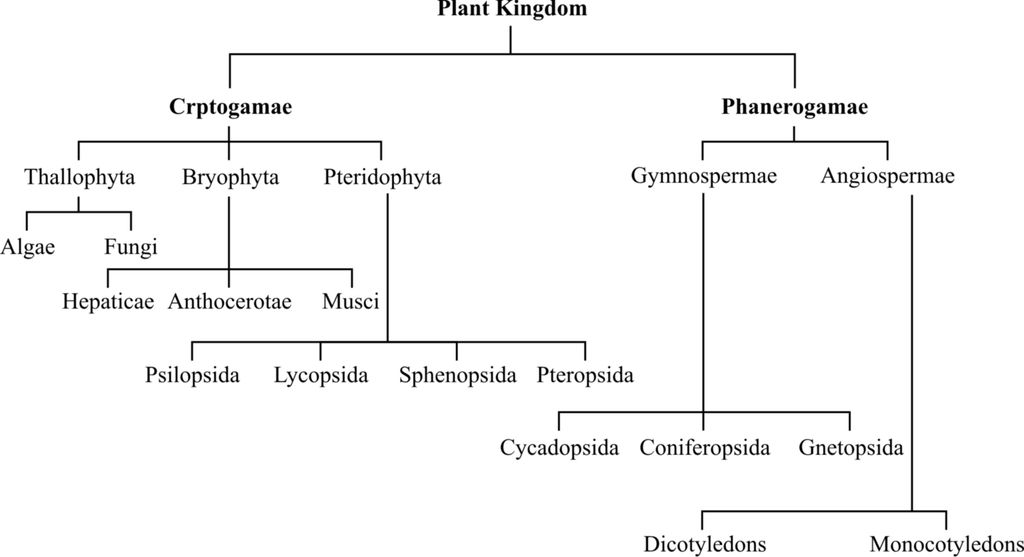
A. EARLY ATTEMPTS FOR CLASSIFICATION
Aristotle and other Greek philosophers divided living organisms into two groups: plants and animals. Aristotle also divided plants into 3 groups-herbs, shrubs and trees.
Charaka (the father of Ayurveda), in 1 st century A.D., listed 200 kinds of animals and 340 kinds of plants in his book 'Charaka Samhita'.
It is based on a few morphological characters of vegetative nature for grouping of organisms, e.g., early systems of classifications by Aristotle, Theophrastus, Pliny, Bauhin, Linnaeus etc.
Theophrastus proposed the first system of artificial classification of plants on the basis of habit and classified plants into herbs, shrubs, undershrubs and trees.
Carolus Linnaeus (1707-1778) proposed the artificial system of classification based exclusively on nature and number of stamens and carpels. It was called as Sexual System of Classification.
Classification by Linnaeus consisted of 24 classes, in which 23 classes were of flowering plants (Phanerogamia) and 24th class had flowerless plants (Cryptogamia). Details of this classification were published in Genera Plantarum (1737).
Total 24 classes given by Linnaeus were: Monandria, Diandria, Triandria, Tetrandria, Pentandria, Hexandria, Heptandria, Octandria, Enneandria, Decandria, Dodecandria, Icosandria, Polyandria, Didynamia, Tetradynamia, Monadelphia, Diadelphia, Polyadelphia, Syngenesia, Gynandria, Monoecia, Dioecia, Polygamia and Cryptogamia.
Drawbacks:
(i) This system was based on one or a few characters, hence the diverse animals or plants were placed into limited number of groups.
(ii) Natural affinities and phylogenetic relationships were not considered.
(iii) The artificial system gave equal weightage to vegetative and sexual characters; this is not acceptable and since we know that often the vegetative characters are more easily affected by environment.
C. Natural System of Classification
Also known as horizontal system of classification or 2 D system. Organisms in this system are classified on the basis of natural affinities. This system uses as many taxonomic characters as possible to group organisms.
This classification is mainly based on forms, relationship realising all information available at the time of collection of plants. This also considers internal features like ultrastructure, anatomy, embryology and phytochemistry .
Common natural systems were proposed by -John Ray, de Jussiaeu, de Candolle, Bentham and Hooker etc.
George Bentham and J.D. Hooker gave most important natural system of classification of angiosperms and published it in three volumes of 'Genera Plantarum'. They described 202 families. In this system, description of plants was based on their detailed studies and dissections. This system is followed in all British Common wealth countries including India
D. Phylogenetic System of Classification
The term phylogeny was given by Lamarck and concept of phylogeny by E. Haeckel. Phylogeny is the evolutionary history of the organism. This system is also called '3D' or vertical system.
In this system, plants are classified according to their evolutionary and genetic affinities. Organisms belonging to same taxa are believed to have a common ancestor and may be represented in the form of family tree called Cladogram.
A.W. Eichler modified Bentham and Hooker's system of classification by placing gymnosperms in the beginning. He is also called as the pioneer in phylogenetic system of classification.
Adolph Engler and Karl A.E. Prantl, two german botanists, adopted their system in "Die naturalichen Pflanzen famhien" (1887-1915). It was a German work which was later translated in English. The work had 23 volumes.
An outline of Engler and Prantl's System of Classification
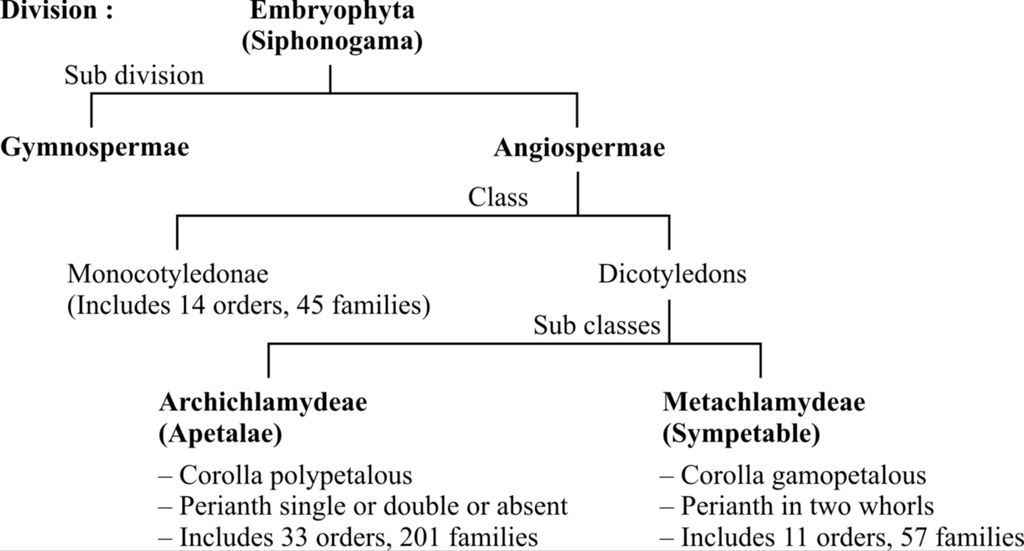
Merits: In this system families are arranged according to increasing complexity of flowers.
Demerits: Monocots were considered primitive to dicots.
According to this system, primitive forms having naked flowers were kept in the beginning. The more advanced families have distinct perianth while the highly evolved families have fused perianth.
Hutchinson, Oswald Tippo, Takhtajan and Cronquist also proposed phylogenetic systems of classification.
John Hutchinson, an English botanist, proposed phylogenetic classification in his famous book 'Famillies of Flowering plants' in 1959.
In Hutchinson's classification:
(i) Trees and shrubs are considered to be more primitive than herbs
(ii) Dicots have been considered more primitive than monocots.
(iii) Polypetalous, actinomorphic and solitary flowers are considered more primitive than gamopetalous, zygomorphic and inflorescence respectively.
An outline of Hutchinson's System of Classification

The divisions include orders that include families. Division does not include classes.
Takhtajan classified Magnoliophyta (Angiospermae) into two classes-Magnoliopsida (dicotyledons) and Liliopsida (Monocotyledons).
BRANCHES OF TAXONOMY
1. Classical Taxonomy:
In this taxonomy, organisms are classified on the basis of natural affinities. These affinities or relationships realise all informations available at the time of collection of plant, e.g., natural systems of classification.
2. Numerical Taxonomy/Phenetics/Taximetrics/Adansonian Taxonomy:
In this taxonomy, there is use of numerical methods for the evaluation of similarities and differences between the species. Firstly, number and codes are assigned to all the characters.
Then, all possible characters are compared by sophisticated calculating machines and computers without giving emphasis on a particular character.
All characters considered for analysis are given equal importance. The organization and analysis of data forms the core of this taxonomy.
The family tree prepared on the basis of phenetics is called dendrogram.
3. Cytotaxonomy/Karyotaxonom
It is based on cytological informations of the cell, chromosome number, structure and behaviour of chromosomes during meiosis
4. Biochemical (Chemotaxonomy) :
It is related with the chemical properties of plant, for example, fragrance by the presence of any aromatic compound, presence of specific crystal structures of calcium oxalate (raphides) or calcium carbonate (cystolith).
The sequencing of DNA and chemical nature of proteins have also been used in this taxonomy.
Taxonomy is divided into three types by Turril.
1. α (Alpha) Taxonomy: It deals with the collection and identification of organism on the basis of gross morphology.
2. β (Beta) Taxonomy : It deals with the collection and identification of organism on the basis of morphology and all possible evidences from cytology, anatomy, physiology and genetics.
3. ω (Omega) Taxonomy : It is based on microscopic observations and biochemical evidences
Algae
- Books Name
- ACME SMART COACHING Biology Book
- Publication
- ACME SMART PUBLICATION
- Course
- CBSE Class 11
- Subject
- Biology
ALGAE
- Algae are chlorophyll containing thallophytes and are characterised by the absence of embryo stage and presence of unicelled non-jacketed gametangia. The study of algae is called algology or phycology.
- The main characteristics of algae are:
1. Algae are usually aquatic, either marine or fresh water, or may occur in a variety of habitats like moist stones, soil and wood.
2. Reserve food is mainly starch.
3. Vascular tissues are absent. Being aquatic, water conduction is not required even in giant forms.
4. Nutrition is autotrophic.
5. Vegetative reproduction by means of fragmentation.
6. Asexual modes of reproduction by means of Mitospores like -Zoospores, Aplanospores, Hypnospores, Akinetes, Palmella stage, etc.
7. Sex organs are non-jacketed. They are unicellular. In case the sex organs are multicellular (e.g., Chara), every cell is fertile.
8. Sexual reproduction involves gametic fusion, that may be isogamy, anisogamy and oogamy in different groups.
9. Life cycle is of various types such as haplontic, diplontic or diplohaplontic.
Concept Builder
1. Algae shows a wide range of forms like -unicellular (e.g., Chlamydomonas), colonial (e.g., Volvox), palmelloid (e.g., Tetraspora), dendroid (e.g., Prasinocladus), filamentous unbranched (e.g., Spirogyra) or branched (e.g, Cladophora), heterotrichous (e.g., Fritschiella, Coleochaete, Stigeoclonium), siphonaceous (e.g., Vaucheria), parenchymatous (e.g., Ulva).
2. F.E. Fritsch (1935) in his book Structure and Reproduction In Algae proposed a practical and sound classification of algae. He divided algae in 11 classes on the basis of pigmentation, reserve food, flagellation, thallus structure and mode of reproduction.
3. Kingdom Plantae of Whittaker (1969) includes mainly three types of algae -red algae, brown algae and green algae.
Comparison of Some Characteristics of Algae

Bryophytes
- Books Name
- ACME SMART COACHING Biology Book
- Publication
- ACME SMART PUBLICATION
- Course
- CBSE Class 11
- Subject
- Biology
BRYOPHYTA
Bryophyta is a small group of plants having multicellular diploid sporophyte living as a parasite on an independent multicellular haploid gametophyte.
On the basis of evolution, bryophytes stand in between algae and pteridophyta. They are the first amphibians of plant kingdom, oldest bryophyte fossils are about 350 million years old.
General characters of Bryophyta :
Bryophytes live in damp, humid and shaded habitats. They may form green carpets or mats on damp soil, rocks, walls, tree trunks during rainy season.
The dominant phase or plant body is a free living gametophyte (n). It is thallus like and may be prostrate or erect.
Vascular tissues are absent.
True stem, leaf and roots are absent. Instead, rhizoids occur for attachment. The latter may be unicellular (e.g., Riccia and Anthoceros) or multicellular (e.g., mosses).
Vegetative reproduction is quite common through fragmentation, tubers, gemmae, buds, adventitious branches etc.
Asexual reproduction by mitospores is absent.
Sex organs are multicellular and jacketed, called antheridium (male) and archegonium (female). The jacket cells are sterile (Bryophytes are first archegoniates).
Antherozoid is twisted and comma shaped with two flagella.
An external layer of water is essential for the swimming of male gametes to reach the archegonia i.e., zooidogamy. So these are called amphibians of plant kingdom.
Zygotes do not undergo reduction division immediately. It develops inside archegonia and divides by mitosis to produce embryo (so these are considered as first embryophytes). The embryo develops further into a sporophyte which is parasitic over the gametophyte (may be partial pasasite as in mosses).
The sporophyte of bryophytes is also called sporogonium, it is composed of three parts viz., capsule, seta and foot. It produces meiospores or haploid spores inside the capsule part (after meiosis in spore mother cells), while attached to the gametophyte.
All bryophytes produce only one type of spores (Homosporous).
On germination each spore produces a gametophyte (either directly or through a juvenile filamentous stage called protonema, e.g., in mosses).
Bryophytes show heteromorphic or heterologous alternation of generations in the life cycle i.e., haplodiplontic life cycle.
Concept Builder
Term bryophyta was proposed by Brown. Hedwig is called father of bryology. Prof. Shiv Ram Kashyap is known as "Father of Indian Bryology".
Aquatic bryophytes are Riccia fluitans, Ricciocarpus, Fontinalis and Riella. Saprophytic bryophytes are Buxbaumia and Cryptothallus, while Frullania is an epiphytic form.
Economic importance of bryophytes
(i) Prevention of soil erosion: Bryophytes, especially mosses, form dense mats over the soil and prevent soil erosion against falling rains.
(ii) Soil formation: Mosses are an important link in plant succession on rocky areas. They take part in building soil in rock crevices formed by lichens. Growth of Sphagnum (Bog moss) ultimately fills ponds and lakes with soil.
(iii) Water retention : Dry Sphagnum has great water absorbing capacity. This characteristic is employed by gardeners to keep seedlings and cut plants moist during transportation and propagation. Sphagnum moss was used in place of absorbent cotton, so is also called cotton moss.
(iv) Peat: Sphagnum often grows in acidic marshes. The older dead parts of moss and other marshy plants got slowly carbonised, compressed and fossilised over thousands of years and have produced a dark spongy mass called peat. Peat is dried, compressed and cut to form blocks. The peat blocks are used as fuel. Peat is also a good manure. It overcomes soil alkalinity and increases its water retention as well as aeration.
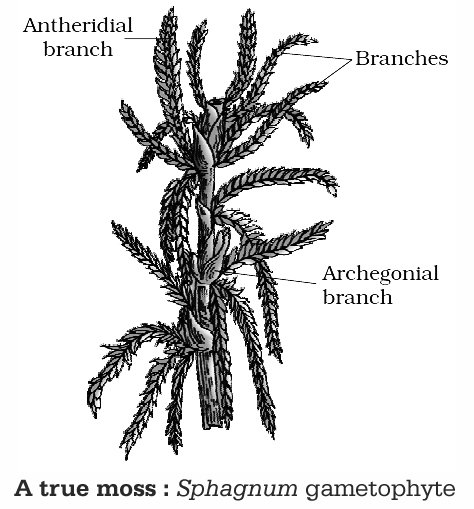
Classification of Bryophyta :

Some characteristic features of these classes are given below:
Hepaticopsida or Liverworts
They have thalloid structure (e.g., Riccia, Marchantia) with dorsiventral symmetry. On the ventral side of the thallus they have multicelled scales and unicelled rhizoids. Thallus has two distinct zones i.e., assimilatory and storage.
Leafy members like Porella have leaf like tiny appendages in two rows on the stem like structures.
Asexual reproduction occur by means of fragmentation, or by specialized structure called gemmae (e.g., Marchantia). These are '8' shaped, stalked, green and multicellular asexual buds developing in small receptacles (gemma cups) on dorsal surface of thallus. Each gemma germinates to produce two thalli in Marchantia.
Antheridia and archegonia are scattered and found embedded in dorsal side of thallus (e.g., Riccia) or may be projected from the thallus in form of stalked receptacles called antheridiophore and archegoniophore respectively (e.g., Marchantia).
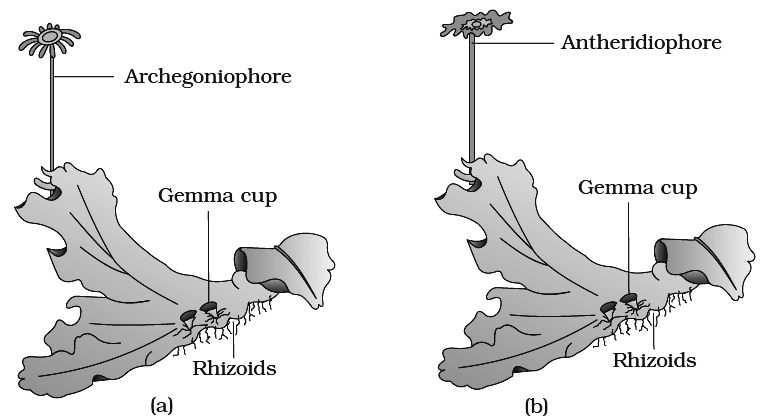
(a) Female thallus (b) Male thallus
Sporophyte may be represented by capsule only (e.g. , Riccia) or differentiated into foot, seta and capsule (e.g., Marchantia).
Capsule may contain spores only (e.g., Riccia) or spores and elaters (e.g., Marchantia). Elaters are diploid, hygroscopic structures with spiral thickenings which help in spore dispersal.
Sporophyte lacks assimilatory tissue, thus it is a complete parasite over the gametophyte.
Spores (n) germinate to form the thalloid gametophyte.
Concept Builder
Anthocerotopsida or Hornworts Anthoceros, Notothylas (Members of Anthocerotae) are called as hornworts, as they possess elongated 'horn like' sporophytes. Capsules of these members contain spores and pseudoelaters (elater like structures without spiral thicknings). Anthoceros cells have one chloroplast with one pyrenoid, so resembles algal thallus.
Bryopsida -Musci or True Mosses:
Gametophytic phase consist of two stages -first is protonema (juvenile stage) , and second is gametophore or leafy stage (mature).
Protonema is filamentous, creeping, green and branched structure developing through spore germination.
Gametophore consist of erect axis bearing spirally arranged leaves and sex organs.
Rhizoids are multicellular (with oblique septa) and branched.
Vegetative reproduction occurs by fragmentation and secondary protonema (filament developing from structure other than spore).
Sex organs develop in the axis of leaves.
The mosses have an elaborate mechanism of spore dispersal from capsule.
Mosses may be known by different names : Cord moss (Funaria), Maiden hair moss (Pogonatum), Peat/Bog moss (Sphagnum) , Hair cap moss (Polytrichum) .
Life cycle of Moss
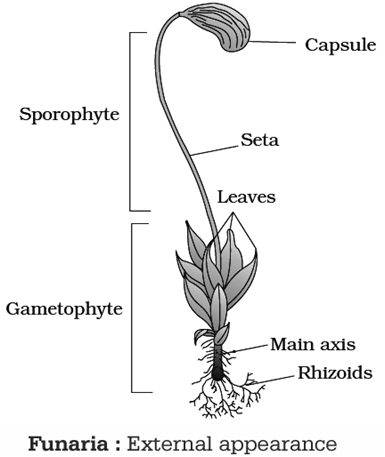
A typical moss plant like Funaria grows in moist, shady places forming dense carpet on soils, rocks, tree trunks etc., during the rainy season.
The radially symmetric plant body is differentiated into stem or axis, leaves or phylloids and rhizoids.
The rhizoids are multicellular. Moss plants multiply extensively by vegetative means.
Reproduction
1. Vegetative reproduction: It occurs by following ways:
(i) Apospory - Formation of gametophyte (i.e., the plant body) from sporophyte without meiosis.
(ii) Protonema buds - Primary protonema formed as a result of spore germination gives rise to group of cells called buds. These buds when separated give rise to new plants.
2. Sexual reproduction: Funaria is monoecious and autoecious plant i.e., male and female sex organs are borne on same plant, but on different branches, called as antheridial and archegonial branch respectively.
Antheridium :
Cluster of antheridia (male sex organ) are borne on antheridial branch, surrounded by a large number of closely arranged perigonial leaves.
An antheridium is a club-shaped structure. Paraphyses occurs mixed with antheridia. Terminal cell of paraphyses is capitate. It is borne over a small multicellular stalk.
There is a single layered jacket which encloses mass of sperm mother cells. Each sperm mother cell (androcyte) produces two biflagellate sperms having curved body.
Archegonium:
At the apex of archegonial branch, archegonia (female sex organ) intermingled with paraphyses are present, surrounded by a cluster of perichaetial leaves.
An archegonium is a flask-shaped structure having a multicellular stalk. It has a tubular neck and a swollen basal venter.
Venter has a two-layered wall which encloses two cells, a venter canal cell and an egg or oosphere. The neck has a single layered wall made of 6-spirally twisted rows of cells.
There is a cover made up of 4-cells. The neck encloses 6-10 Neck Canal Cells (NCC). At maturity, the neck canal and venter canal cells gelatinises. The lid cells separate.
The opened archegonia attract sperms by sucrose and K+ ions present in their mucilage. A sperm enters an archegonium, fuses with the oosphere and forms a diploid zygote or oospore
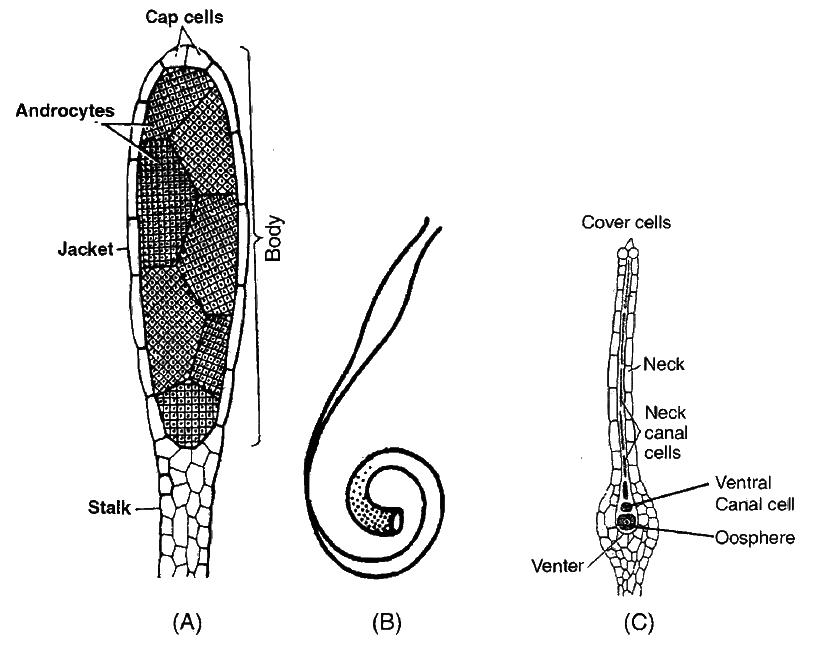
Development of sporophyte
The venter cells form a cover over zygote called calyptra (haploid -gametophytic tissue). The diploid oospore develops into a sporophyte. Sporophyte consists of three parts-foot, seta and capsule. Foot is embedded in the tip of gametophytic plant. It takes part in fixation of sporophyte and absorption of water and mineral salts from the gametophyte.
Seta is a narrow stalk which lifts the capsule in the air. The capsule is further differentiated into 3 parts-apophysis, theca and operculum. Apophysis contains assimilatory tissue and stomata (having a single circular guard cell).
Theca contains a central sterile column or columella, two spore sacs, air cavity and some assimilatory tissue. Its tip contain two rows of acellular teeth called peristome.
There are 32 peristomial teeth in each capsule arranged in two rows of 16 each. The teeth in outer row (exostome) are dark brown and hygroscopic in nature, and also have transverse bands of cellulose.
However teeth of inner row (endostome) are thin, light brown and non-hygroscopic. Inside the spore sac, diploid spore mother cells are formed.
They undergo meiosis and produce haploid spores.
The haploid spores are liberated from the capsule by removal of operculum and hygroscopic movement of peristomial teeth.
Since Funaria like mosses have some assimilatory tissue or cells with chloroplast in their sporophyte, unlike liver worts, sporophyte of mosses are often called as semiparasite over the gametophyte. Such cells are present in the apophysis, capsule wall and in the spores.
On germination, each haploid spore produces a filamentous juvenile gametophyte called protonema. Protonema has two types of branches, green and nongreen.
The nongreen branches (rhizonema) are subterranean. They function as rhizoids. Green branches (chloronema) are epiterranean.
Protonema can multiply vegetatively. It ultimately bears buds on its green branches. The buds grow to form moss plants. The latter, therefore, represent adult gametophyte.
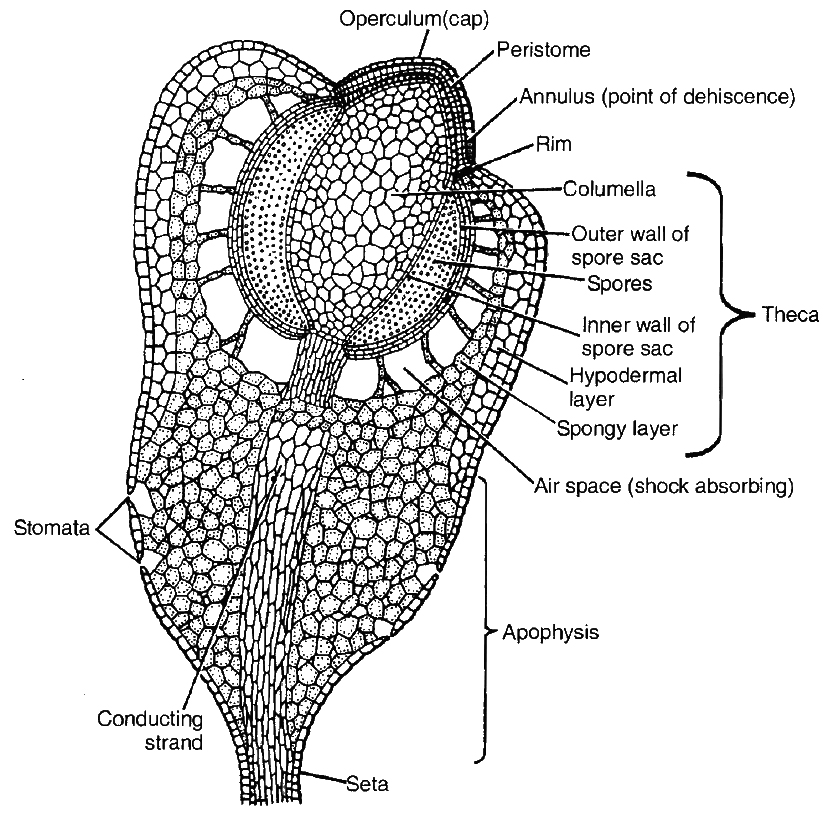
Pteridophytes
- Books Name
- ACME SMART COACHING Biology Book
- Publication
- ACME SMART PUBLICATION
- Course
- CBSE Class 11
- Subject
- Biology
PTERIDOPHYTA
General characters of pteridophyta
They are most primitive vascular, flowerless, seedless, spore producing cryptogamic land plants. Commonly called vascular amphibians "or" botanical snakes. These are first successful plants on land. Evolutionarily these are first terrestrial plants to possess vascular tissues.
Term pteridophyta was given by Haeckel.
1. Dominant phase of plant body is a sporophyte.
2. Plant body is differentiated into true stem, leaves and roots.
3. Vascular tissues are present. They are of two types, xylem and phloem. In xylem , true vessels are absent. In phloem, companion cells and sieve tubes are absent. Instead, sieve cells are present. Secondary growth is exceptionally present in Isoetes and Botrychium.
4. On the basis of leaves pteridophytes are of two types. In megaphyllous plants, leaves are large in relation to stem and leaf trace is broken by leaf gaps, e.g., ferns. In microphyllous forms, leaves are small and receive a single unbroken leaf trace, e.g., club moss and horsetails.
5. Sporangia are associated with leaves called sporophylls. Meiospores are formed inside sporangia. In some cases sporophytes may form distinct compact structures called strobili or cones (Selaginella, Equisetum).
6. Spore on germination produces small, reduced, free living', independent, multicelled, non-vascular, haploid gametophyte. This thalloid gametophyte is called prothallus. These require cool, damp shady places to grow. Because of this restricted requirement and the need of water for fertilization are reasons due to which the spread of living pteridophytes is limited and restricted to narrow geographical regions. The development of gametophyte may be endosporic (inside the spore wall) or exosporic (outside the spore wall).
7. Sex organs are multicellular and jacketed. Number of NCC in archegonia may be one uninucleate (Selaginella) or one binucleate (ferns).
8. Sperms are flagellated. They require an external supply of water for swimming to reach archegonia. The chemical stimulus is provided by malic acid.
9. Embryo stage is present.
10. Heteromorphic or heterologous alternation of generation is present in the life cycle.
11. Pteridophytes are divided in four groups, viz., Psilophyta (Psilotum), Lycophyta (Lycopodium, Selaginella), Sphenophyta (Equisetum), and Pterophytai/Filicophyta (Dryopteris, Pteris, Adiantum, Salvinia).
12. True ferns are leptosporangiate members of Filicophyta and are most conspicuous of the pteridophytes.
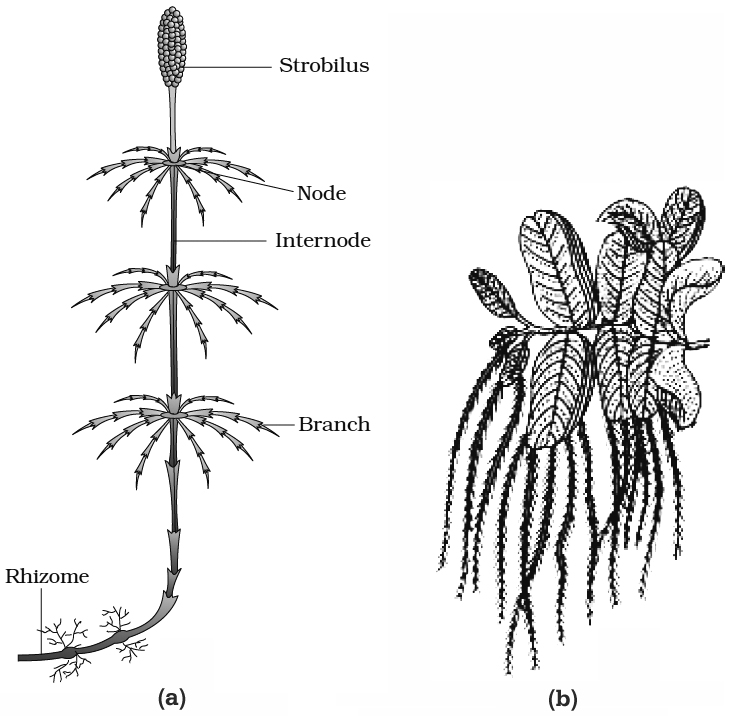
Concept Builder
1. Sporangium development is of two types in pteridophytes:
(i) Leptosporangiate -When sporangium develops from single superficial cell, e.g., Pteris, Dryopteris, Adiantum.
(ii) Eusporangiate -When sporangium develops from group of cells, e.g., Selaginella, Equisetum
2. Majority of pteridophytes produce same type of spores (homosporous, e.g., ferns like Adiantum, Pteris, Dryopteris). Only a few produce different types of spores, namely megaspores and microspores (heterosporous, e.g., Selaginella, Marsilea, Salvinia, Azolla etc.). Heterospory leads to seed habit in plants.
3. Embryogeny in pteridophytes is of two types:
(i) Exoscopic embryogeny : Axis of embryo is directed towards archegonial neck, e.g., Equisetum.
(ii) Endoscopic: Axis of embryo is directed inward towards venter, e.g., Selaginella.
4. Development of embryo may be :
(i) Holoblastic -When entire zygote is involved in embryonic development, e.g. , Ferns.
(ii) Meroblastic -When part of zygote is involved in embryonic development, e.g., Selaginella.
Stelar system
The central vascular cylinder of axis of pteridophytes is referred to as stele. It is a primary vascular tissue consisting of pith, xylem, phloem and pericycle.
It first appeared in pteridophytes like Rhynia. So lets study different types of steles proposed by Van Teigham and Douliot.
Types of stele :
1. Protostele: Simplest type, without pith
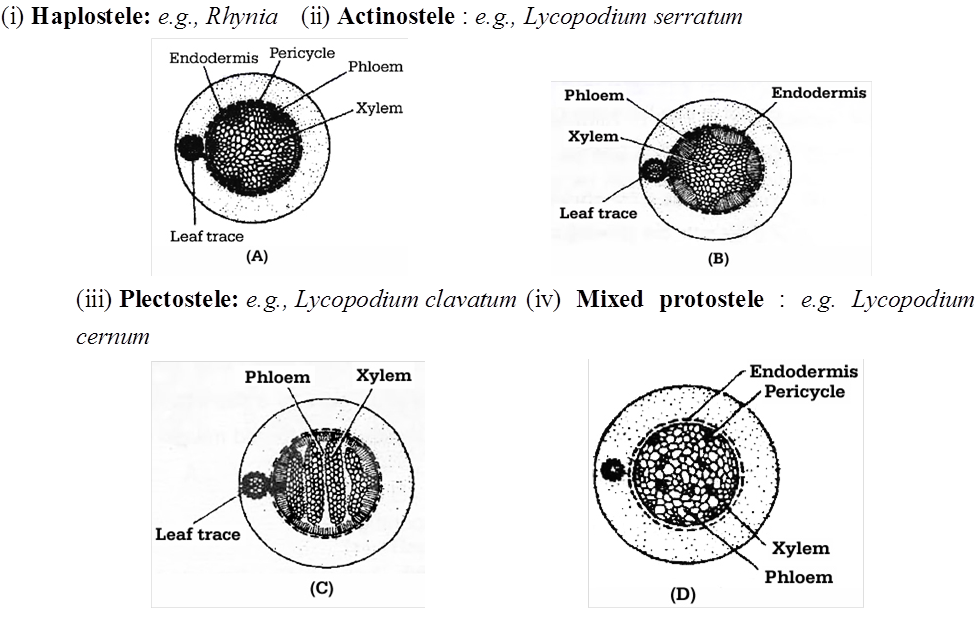
2. Siphonostele: With pith
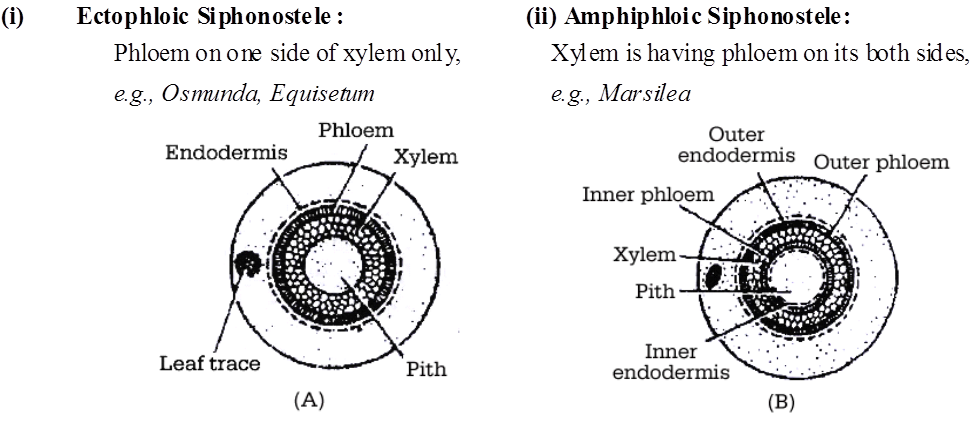
(iii) Solenostele : Stele with one or few non (iv) Dictyostele : Stele with large number of
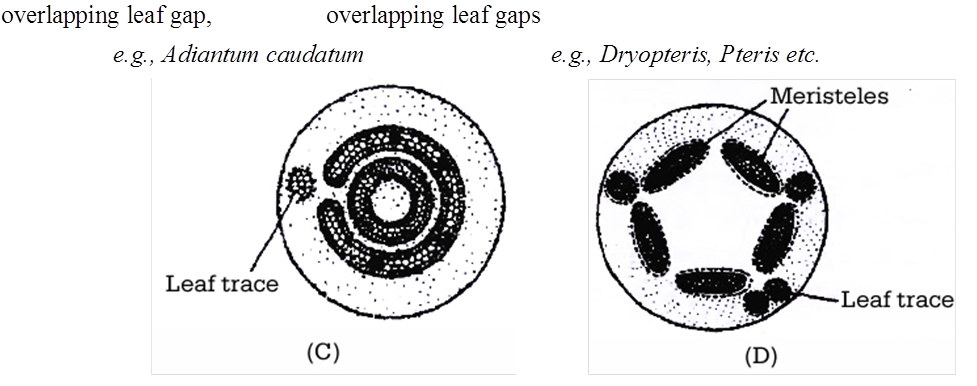
The specific features of true ferns are as follows :
i. The stem is underground rhizome (sometimes oblique, called root stock) in most of the ferns, except in tree ferns like Cyathea, Alsophyia where the stem is aerial.
ii. Leaves are large and are called fronds. Leaves may be simple or pinnately compound.
iii. Young leaves show circinate ptyxis, as they are coiled in the form of a watch spring. This coiling protects the growing point which comes to lie in the centre.
iv. Younger parts of stem, young leaves, petiole and rachis of mature leaves possess brown stiff hairs called ramenta. Ramenta protect them from mechanical injury and desiccation.
v. Sporangia occurs on the ventral surface of leaves in clusters called sori (singular-sorus). The fertile leaves are known as sporophylls. A sorus is covered by a flap-like outgrowth from its surface called indusium (true indusium, e.g., Dryopteris) or turned margin of the sporophyll (false indusium , e.g., Adiantum).
vi. Development of sporangium in true ferns is leptosporangiate.
vii. The male gamete is spirally coiled and multiciliated.
Life cycle of a fern (Dryopteris)
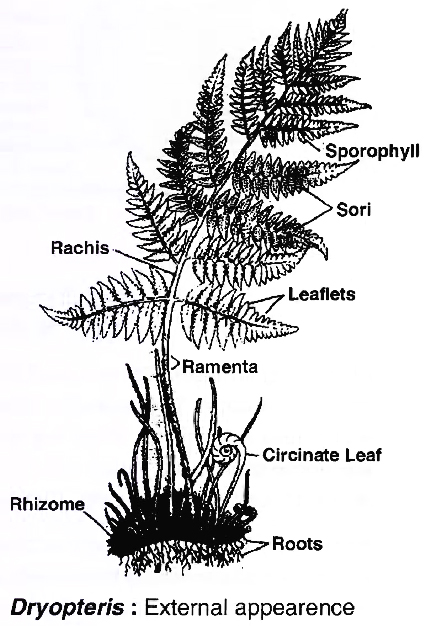
Plant body is a perennial, independently living evergreen sporophyte. It is differentiated into stem, leaves and roots. Roots are adventitious.
Stem is an underground dark brown rhizome.
The large aerial leaves or fronds develop acropetally in spirals from the upper surface of the rhizome.
The young leaves show circinate ptyxis. Persistent leaf bases of the dead leaves are found in older parts of rhizome.
Venation is open furcate in leaflets. Ramenta or paleae are present.
Reproduction
The fern multiplies vegetatively by fragmentation of rhizome and development of adventitious buds.
In Dryopteris, the adventitious buds present at leaf base separate and grow into a new plant.
In Adiantum caudatum and a few other species, adventitious buds develop at leaf tips.
When such leaf tips happen to touch the soil, they form new plants.
The process helps in spreading the fern over a large area. Because of this reason A. caudatum is also called walking fern.
Ventral surface of leaflets of a mature leaf bear yellowish brown clusters of sporangia called sori. The leaves having sori or sporangia are called sporophylls.
In Dryopteris, the sori develop in two rows, one on either side of the veins. Each row contains 4-6 sori. Each sorus is covered by a membranous sheath of its own.
This covering is called true indusium. The covered sori of Dryopteris are kidney-shaped in outline. This has given the name of male shield fern to Dryopteris.
A sorus consists of a parenchymatous cushion of placenta. The placenta bears a number of stalked biconvex sporangia. In each sporangium, there is a single layered jacket that encloses 12-16 diploid spore mother cells.
A marginal row of jacket cells are differentially thickened to form annulus. The remaining marginal cells constitute stomium. The diploid spore mother cells divide meiotically to form haploid spores.
With the maturity of spores, the indusium shrivels. The exposed sporangia dehisce in the region of stomium due to differential contraction of annulus. The spores are thrown away. They are dispersed by air currents.

A. Fern leaflet (Sporophyll) showing sori, B. V.S. Sporophyll, C. A Sporangium
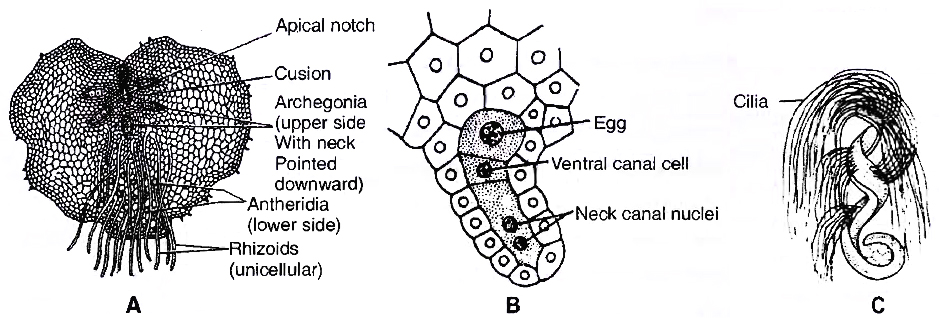
B. One archegonium C. One antherozoid
After falling on a suitable soil, each spore germinates to form a flat, heart shaped, green, thalloid gametophyte called prothallus.
The prothallus is monoecious, that is, it bears both the types of sex organs, male antheridia and female archegonia. They are borne ventrally.
Antheridia occur in the area of rhizoids, while archegonia are borne behind the apical notch in an area called apical cushion. Antheridium has a 3 celled jacket and about 32 sperm mother cells. The sperms are multiflagellate (= multiciliate) and spirally twisted.
Archegonium is flask-shaped in outline. It has an embedded venter and a projecting neck. Neck has 4-rowed wall which encloses a single binucleate neck canal cell.
The venter contains a single venter canal cell and an oosphere. In the mature state, the venter canal cell and the neck canal cells gelatinise. The neck opens.
Sperms are attracted to the opened archegonia by malic acid (chemotactic stimulus) present in their mucilage. A sperm fuses with an oosphere to form a diploid oospore.
The oospore gives rise to an embryo which grows in size to form the fern plant.
Life Cycle of Selaginella :
Salient features
Plant body is an evergreen sporophyte. It is differentiated into stem, leaves and roots. The roots often develop at the tips of special structures called rhizophores.
Plant body of Selaginella chrysocaulos and S.selaginoides is erect. Its leaves are isophyllous and arranged in two rows. In S.kraussiana the plant body is prostrate. Its leaves are anisophyllous or dimorphic and arranged in four rows.
Bower and Goebel named rhizophore of Selaginella as an organ sui-generis, i.e., an organ having the characters of both stem as well as root, but independent in origin.
The stem in Selaginella is distelic. 'Rarely stem is monostelic.
The plant body can multiply vegetatively by fragmentation, bulbils and tubers. Bulbils and tubers help in perennation as well.
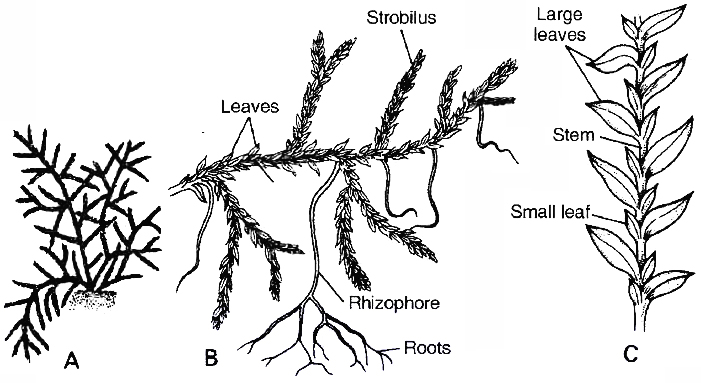
C. Arrangement of leaves
Sporangia develop in the axil of fertile leaves or sporophylls at the tips of small branches called spikes. There are two types of sporangia, microsporangia and megasporangia, hence this genus is heterosporous.
Each microsporangium produces a large number of small haploid microspores. A megasporangium develops only four haploid megaspores. Growth of the gametophytes is precocious.
Microspore produces an endosporic 13-celled male gametophyte. The latter has one prothallial cell, 8 jacket cells and four androgonial cells. The androgonial cells form 128-256 androcytes or sperm mother cells. A sperm mother cell gives rise to a biflagellate sperm.
Megaspore produces a partially exosporic female gametophyte. The female gametophyte contains an exposed generative apical cushion and a storage tissue. The two are separated by a
diaphragm
The apical cushion produces archegonia and rhizoids. Each archeogonium has a single female gamete or oosphere. The mucilage oozing out of neck of archegonium in Selaginella and fern contains malic acid.
The neck of archegonium in Selaginella and fern contains only one neck canal cell. Fertilization requires the help of external water for swimming of sperm. It produces diploid oospore.
Oospore divides to form a suspensor and embryo. The development of embryo is meroblastic. Suspensor helps in pushing the embryo into food laden storage tissue. Embryo has a foot for absorbing nourishment, a shoot tip and a root tip. The latter two elongate and produce an independent sporophytic plant body.
Selaginella shows two distinct generations, sporophyte and gametophyte, one producing the other. They are morphologically different. The phenomenon is called heteromorphic or heterologous alternation of generations.
Concept Builder
1. Common names Spike moss (Selaginella)
Bird's nest moss (Selaginella rupestris)
Club moss (Lycopodium)
2. Smallest pteridophyte =Azolla pinnata (an aquatic fern). It is commonly used as biofertilizer.
3. Largest pteridophyte = Cyathea (tree fern)
4. Apogamy : It is development of haploid sporophyte from gametophyte without fertilisation. It was reported by Farlow in Pteris cretica.
5. Apospory : It is development of diploid gametophyte from sporophyte without meiosis. It was reported by Druery in Athyrium. Due to apospory, polyploidy is common in ferns.
6. Psilotales like Rhynia (fossil) were first tracheophytes.
7. Psilotum shows presence of rhizoids and dichotomous branching of stem.
8. Under dry conditions, the xerophytic species of Selaginella roll into brown balls. The phenomenon is called cespitose habit. In this state, it may be uprooted. The brown balls become green and unroll again under moist conditions. Because of this characteristic, these plants are known as resurrection plants, e.g., S.lepidophylla, S.bryopteris.
9. Selaginella rupestris shows a near approach to seed habit.
Gymnosperms
- Books Name
- ACME SMART COACHING Biology Book
- Publication
- ACME SMART PUBLICATION
- Course
- CBSE Class 11
- Subject
- Biology
GYMNOSPERMS
The term gymnosperm was used by Theophrastus (300 Be) in his book Enquiry into plants.
They are popularly called naked seeded vascular plants. Goebel called them as phanerogams without ovary.
It is smallest group of plant kingdom.
General characters of gymnosperms:
Majority of gymnosperms are perennial woody plants forming either shrubs or trees. Ephedra is a climber. Some of these are very large and live for thousands of years, e.g., Sequoia.
Unlike bryophytes and pteridophytes, in gymnosperms the male and female gametophytes do not have an independent free living existence.
Tap root system is present. Cycas also has special azeotropic N2 fixing coralloid roots having association with Anabaena cycadae (BGA). Pinus root shows symbiotic relation with ectomycorrhiza.
The leaves may be simple (Pinus) or compound (Cycas). These leaves are well adapted to withstand extremes of temperature, humidity and wind, e.g., Needle leaf of Pinus. Scale leaves may also be present.
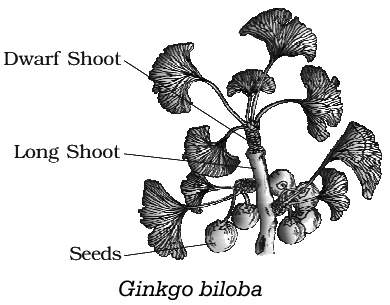
Stem is woody and branched (Pinus, Cedrus) or unbranched (Cycas).
These are heterosporous. There occurs two types of sporophylls; microsporophylls and megasporophylls. The two types of sporophylls are usually aggregated to form compact cones (strobili) i.e., pollen cones (male cones) and seed cones (female cones).
Microsporophylls do not show distinction of filament and anther.
The micros pores develop into a male gametophyte which is highly reduced and is confined to only a limited number of cells. This reduced male gametophyte is called pollen grain. The development of pollen grains takes place within the microsporangium.
Megasporophylls are not rolled like carpels. A distinction of ovary, style and stigma is absent.
Ovules (integumented. megasporangium) lie exposed on the megasporophyll. Each ovule is surrounded by a 3-layered single integument (Bitegmic in Gnetum).
Female gametophyte contains archegonia (Absent in certain members of order Gnetales)
Pollination is direct as a stigma is absent and the pollen grains directly reach the micropylar end of ovules. Pollination is usually accomplished by wind (anemophily).
Male gametophyte produces only two male gametes or sperms. Generally, one of them is functional.
External water is not required for transport of male gametes. Instead, a pollen tube is formed by the male gametophyte for effecting fertilization (siphonogamy).
Seeds contain a food laden tissue or endosperm for future growth of embryo into seedling. This tissue represents the female gametophyte, hence haploid.
Like pteridophytes, xylem does not possess vessels, except in some Gnetales. Phloem is without companion cells. Albuminous cells perform the function of companion cells. Sieve tubes are also not formed as the sieve cells are not arranged end to end in rows.
Vascular tissues are arranged into vascular bundles just like angiosperms.
Foliage leaves do not have lateral veins. Transfusion tissue (hydrostereom) occurs internally for lateral transport.
Wood is soft and homoxylous but members of Gnetales bear vessels in xylem.
Types of wood :
(i) Manoxylic :
Soft wood, vascular tissues with medullary rays, commercially less important, e.g., Cycas.
(ii) Pycnoxylic :
Compact wood without or with narrow medullary rays, commercially more important, e.g., Pinus.
(iii) Monoxylic :
With single persistent cambium ring and bundles, e.g., Pinus
(iv) Polyxylic :
With many persistent cambium rings and bundles, e.g., Cycas
Gymnosperms are, therefore, those seed plants in which the ovule remains exposed over the surface of the megasporophylls both before and after fertilisation.
Concept Builder
1. Smallest gymnosperm = Zamia
Largest gymnosperm = Sequoia
2. The three generations in seed are:
- (i) Testa, tegmen and perisperm represent parental sporophyte
- (ii) Endosperm represents female gametophyte;
- (iii) Plumule, radicle, suspensor and cotyledons (embryo) represent future sporophyte.
3. Polyembryony: It is the formation of more than one embryo inside a single seed. It was reported by Leeuwenhoek in oranges. Simple polyembryony is due to fertilisation of many eggs, e.g. Pinus ovule has 2-8 archegonia. Cleavage polyembryony is true polyembryony and very common. It is due to splitting of embryo tissue. Adventive polyembryony is the formation of extra embryos directly from diploid cells (e.g., rosette cells) other than embryonal cells.
4. Order Gnetales consists of Gnetum, Ephedra and Welwitschia. These are nearer to flowering plants in having flower like arrangement of sporophyll and possessing primitive vessels in xylem so wood is called heteroxylous. Plants of Cycadales and Coniferales are commonly called Cycads and Conifers respectively.
5. Cycas, Ginkgo and Metasequoia are living fossils.
6. Ginkgo biloba (Pagoda tree or Maiden hair tree) is oldest living fossil and it is connecting link between cycades and conifers.
7. Largest ovule (found in Cycas revoluta)
8. Largest male cone (in C. circinalis)
9. Largest male gamete (sperm) in Cycas
10. Largest female gamete (egg) in Cycas
11. Independent, free living, photosynthetic gametophyte is not found in gymnosperms and angiospersm.
12. Gymnosperms are divided into four orders-Ginkgoales, Gnetales, (e.g. Ephedra, Gnetum, Welwitschia), Cycadales and Coniferales. Ginkgoales is represented by maiden hair tree (Ginkgo biloba) where Ginkgo biloba happens to be only living member, rest all are extinct. So it is also called as living fossil.
Economic Importance
i. Edible Seeds. Seeds of Pinus gerardiana called chilgoza are edible.
ii. Timber. Gymnosperms possess soft wood. The same is used in preparation of light furniture , plywood, packing cases, match sticks, railways sleepers, etc, e.g., Cedrus deodara.
iii. Resin. Resin is a semifluid secreted by special resin canals. It solidifies on exposure to air. Therefore, it plugs the places of injury. It helps in sealing female cones after pollination. Resin is commercially extracted and distilled to obtain turpentine and resin. Resin is used in water proofing, sealing joints and preparation of writing paper. Turpentine is used as solvent in paints, polishes and wax, e.g., Pinus.
iv. Ephedrine. Drug ephedrine is obtained from Ephedra. The drug is used in curing respiratory elements including asthma.
v. Sago. A starchy food sago is obtained from stem of Cycas revoluta which is thus also called as sago palm.
vi. Canada balsam. A mounting agent used in preparation of permanent slides is obtained from Abies balsamaea.
vii. Cedar wood oil. Useful in microscopy is obtained from Juniperus virginiana.
viii. Taxol. Anticancerous chemical obtained from Taxus.
Life Cycle of Pinus
Pinus is a coniferous gymnosperm.
It is a large tree having pyramidal or excurrent shape like a "Christmas tree". The plant body is a sporophyte having stem, leaves and roots.
The main stem is straight. Stem branches are dimorphic i.e., of two types, long and dwarf. Long shoots show unlimited growth and bear only scale leaves. The dwarf branches possess 1-5 needle-like foliage leaves which are surrounded at the base by a sheath of scare leaves.
Pinus has a horizontally spreading tap root system with peg-like downwardly directed roots present at intervals.
Finer roots are of two types-normal (with root hairs and root cap) and mycorrhizal. The mycorrhizal roots occur near the soil surface.
They are devoid of root hairs and root cap. Mostly Boletus (fungus) forms an ectomycorrhiza with roots of Pinus.
The sporophytic plant body does not multiply vegetatively. It is a monoecious tree. It produces microsporophylls and megasporophylls in two types of cones, male and female.
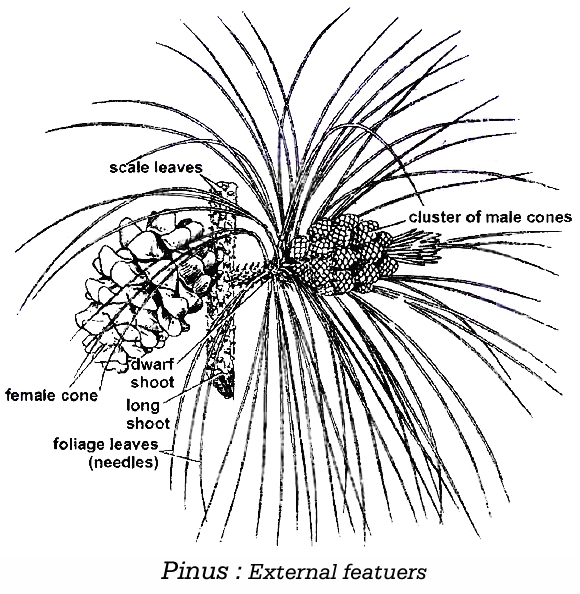
Male or Pollen Cones
These are non-woody structures occurring sub-terminally in clusters on lower long branches.
These cones are homologous to dwarf shoots. Each male cone has a short stalk, a central axis and a number of spirally arranged microsporophylls.
A microsporophyll bears two oblong, parallel microsporangia on its lower surface. In a microsporangium, the diploid microspore mother cells undergo meiosis and form haploid microspores or pollen grains.
The pollen grains are released from the male cones at 4 celled stage, having two prothallial cells, one generative cell and one vegetative cell and dispersed by air currents.
They form yellow clouds in the pine forests called as 'sulphur shower'. A pollen grain has two air sacs or wings for making it light, which are formed by its exine
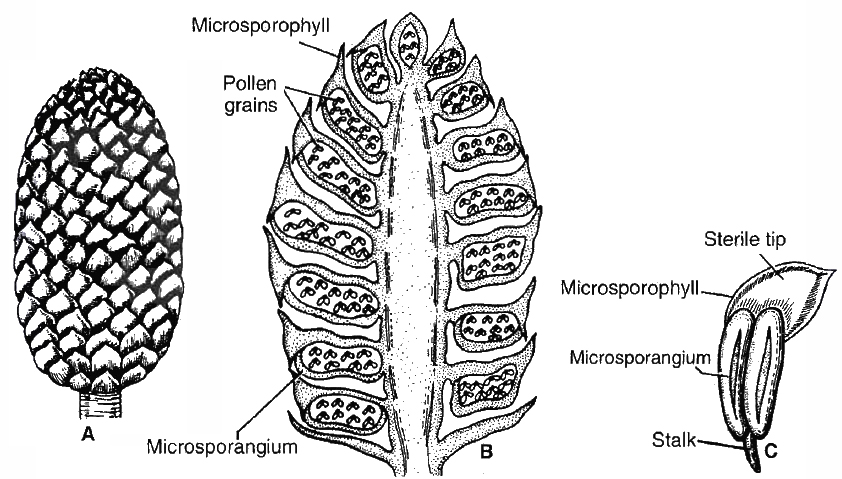
C. microsporophyll ventral view
Female or Seed Cones
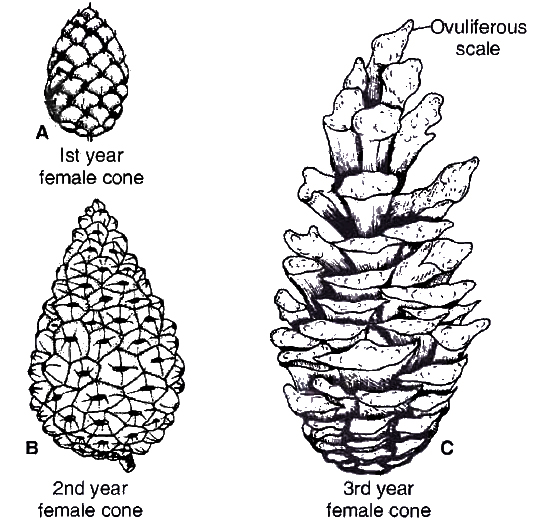
C. Third year female cone
These are initially green but become woody and brown at maturity.
They develop in groups of 2-6 on upper long branches of the tree. These are homologous to long shoots.
Each female cone has a long stalk and a central axis on which are borne a number of spirally arranged paired scales. The lower of the pair is called bract scale while the upper scale is ovuliferous scale.
The ovuliferous scale bears two ovules towards the basal region on the upper side.
Each ovule has a 3-layered integument with a terminal wide, oblique pore or micropyle and nucellus (= megasporangium). In the middle of nucellus, a megaspore mother cell differentiates.
It forms four haploid megaspores by meiosis but only one survives.
The functional megaspore gives rise to female gametophyte called endosperm.
The female gametophyte bears 1-8 archegonia. An archegonium has a short neck and a large venter.
Neck canal cell is absent. Venter canal cell is ephemeral. The venter contains a large egg or oosphere.
Pollination is anemophilous (by air) and direct. The formation of male gametes occur after pollination.
The pollen grains pass into the opened micropyle and rest on the tip of nucellus, where they are caught in the mucilagenous pollination drop oozed out by terminal part of nucellus.
Here each pollen grain germinates and forms a pollen tube (siphonogamy) but further growth is stopped due to arrival of winter in the first year.
Fertilization occurs after 13 months from the time of pollination. In the spring of next year, fertilization occurs.
Pollen tube grows and pierces an archegonium.
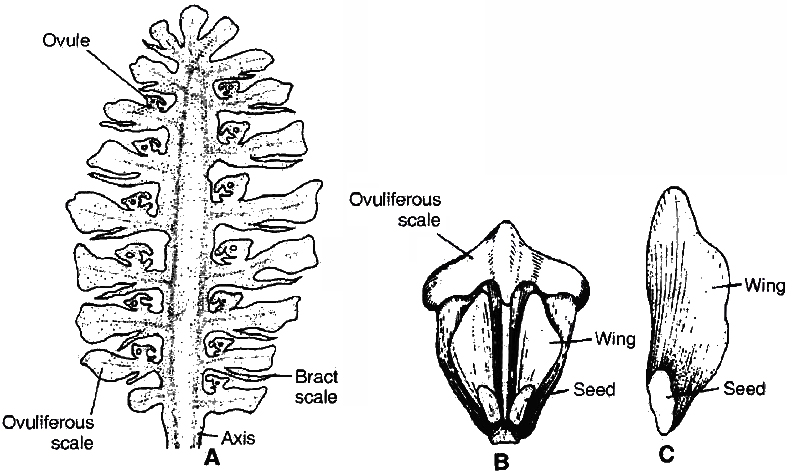
One male gamete or male nucleus fuses with the oosphere to form diploid zygote or oospore. The oospore forms an embryo while the ovule matures into a seed.
Part of the upper surface of the ovuliferous scale is peeled off alongwith the seed to form its wing.
A female cone takes about 26 months for reaching maturity. It then opens to release winged seeds which are dispersed by air. After falling on a suitable soil, each seed gives rise to a new plant.
Concept Builder
(a) Development of embryo is meroblastic in Pinus.
(b) The number of cotyledons in Pinus ranges from 3 -18.
(c) There are 4 tiers in proembryo, namely basal embryo tier, suspensor tier, rosette tier and upper tier.
(d) Development of sporangium in Pinus is eusporangiate.
(e) Pinus shows polyembryony by three methods -simple, cleavage and adventive.
Salient Features of Cycas (Sago Palm)
Cycas is called Palm-fern. It bears crown of leaves on unbranched stem called caudex like palms. It also shows circinate ptyxis and presence of ramenta like ferns.
Roots are of two types-normal tap root and ageotropic coralloid roots. Latter are formed in form of coralline masses which bear blue green algae in their cortical cells, e.g., Anabaena, etc. They help in nitrogen fixation.
Leaves are of two types-scale and foliage, both arising in whorls. Every year almost one is added.
Old leaves fall and leave characteristic leaf scars on the stem. Foliage leaves are leathery and pinnately compound. Scale leaves are brown, and membranous.
Stem of Cycas shows manoxylic and polyxylic wood.
Rachis shows presence of diploxylic vascular bundles arranged in shape of inverted omega (w).
Transfusion tissue replaces lateral veins in the leaves for lateral transport of food.
Plants are dioecious. Male cones are found but female cones are absent (loose megasporophylls). Largest egg, sperm and ovule are found in Cycas. Ovules are orthotropous.
Sperms in Cycas are multiflageliate (= multiciliate). Pollen tube is formed in Cycas, but is haustorial in nature. Thus, Cycas shows both siphonogamy and zooidogamy.
Angiosperms
- Books Name
- ACME SMART COACHING Biology Book
- Publication
- ACME SMART PUBLICATION
- Course
- CBSE Class 11
- Subject
- Biology
ANGIOSPERMS (FLOWERING PLANTS OR ANTHOPHYTES)
Angiosperms-Classification up to Class
After Linnaeus work on classification of plants, the taxonomists realised the necessity of information on natural history of vegetation and the affinities at various levels of hierarchy.
George Bentham and J.D. Hooker gave most important natural system of classification of angiosperms and published it in three volumes of Genera Plantarum.
They described 202 families. In this system, description of plants was based on detailed studies and dissections.
This system is followed in all British Commonwealth countries including India.
The system being handy, it is preferred and used by the students in practical classes. This system covered about ninety seven thousand species of seed plants.
In Bentham and Hooker system of classification, phanerogams were divided into three classes on the basis of morphological characters, such as leaf arrangement and venation pattern, number of members in floral whorls like calyx, corolla, androecium and gynoecium, number of cotyledons in the seed and seeds with or without cover.
In this classification, Class is like division, series is like class, cohort is like order and order is like family.
An outline of the Bentham and Hooker classification of phanerogamia is given below:
Class 1 : Dicotyledonae
General characters
Pentamerous flower, reticulate venation in leaves, two cotyledons in seed, open vascular bundles (with cambium), secondary growth present, wood formation occurs.
It is divided into 3 sub-classes
Sub-class 1 : Polypetalae -Petals free.
It includes three series:
Series 1 : Thalamiflorae -Flower hypogynous, stamens and pistils many (indefinite), petals free, distinct sepals are free from ovary. It has 6 orders, e.g., Ranales, Parietales, Malvales etc.
Series 2 : Disciflorae -Flower hypogynous, Calyx consists of free or united sepals, Petals free, a prominent cushion shaped disc is present below ovary. It has 4 orders, e.g., Sapindales, Geraniales etc.
Series 3 : Calyciflorae -Flower perigynous or epigynous, calyx contains united sepals (rarely free), ovary inferior. It has 5 orders, e.g., Rosales, Umbellates etc.
Sub-class 2 : Gamopetalae -Petals united or fused.
It includes 3 series:
Series 1 : Inferae -Flower epigynous, ovary inferior, stamens as many as corolla lobes or fewer. It has 3 orders, e.g., Asterales, Campanulates etc.
Series 2 : Heteromerae -Ovary usually superior, carpels more than two. It has 3 orders , e.g., Ericales, Primulales, Ebenales.
Series 3 : Bicarpellatae -Ovary usually superior, two carpels (rarely one or three) . It has 4 orders, e.g., Lamiales, Polemoniales etc.
Sub-class 3 : Monochlamydeae -Flower incomplete, no distinction between calyx and corolla, pe¬rianth present which is usually sepaloid and may be absent.
It includes 8 series:
Series 1 : Curvembryeae -Embryo curved, generally one ovule.
Series 2 : Multiovulatae Aquaticae -Plants are aquatic, submerged herbs, syncarpous ovary.
Series 3 : Multiovulatae Terrestres -Plants are terrestrial, syncarpous ovary.
Series 4 : Microembryae -Very minute or small embryo.
Series 5 : Daphnales -Ovary with one carpel and one ovule.
Series 6 : Achlamydosporeae -Ovary unilocular with one to three ovules. Ovary inferior.
Series 7 : Unisexuales -Flower unisexual.
Series 8 : Ordines Anomali -Families having plants with anomalous (abnormal) characters.
Class 2 : Gymnospermae
Sex organs are cones, perianth absent, ovule naked (not found inside ovary), seeds are also naked, haploid endosperm.
It has three families -Gnetaceae, Coniferae and Cycadaceae.
Class 3 : Monocotyledonae
Parallel venation in leaves, embryo with one cotyledon, flower usually trimerous, wood absent, no secondary growth.
It include 7 series:
Series 1 : Microspermae -Ovary inferior, seed minute.
Series 2 : Epigynae -Ovary inferior, seeds larger.
Series 3 : Coronarieae -Ovary superior, perianth coloured.
Series 4 : Calycineae -Ovary superior, perianth green.
Series 5 : Nudiflorae -Perianth absent, ovary superior.
Series 6 : Apocarpae -Carpels free (apocarpous).
Series 7 : Glumaceae -Flowers arranged in spikelets with bracts, perianth reduced, bracts large and scaly.
Merits of Bentham and Hooker's System
1. It is useful for practical value.
2. Ranales have been given the most primitive position among dicots.
3. Glumaceae is considered most advanced among monocots.
Demerits of Bentham and Hooker's System.
1. Gymnosperms were placed between dicots and monocots.
2. Many important floral characters have been neglected.
3. It is not a phylogenetic system and believes in the fixity of species.
4. Some closely related families were separated and placed under different cohorts (order) and unrelated families have been put nearer.
5. Advanced family like Orchidaceae (Microspermae) have been considered as primitive
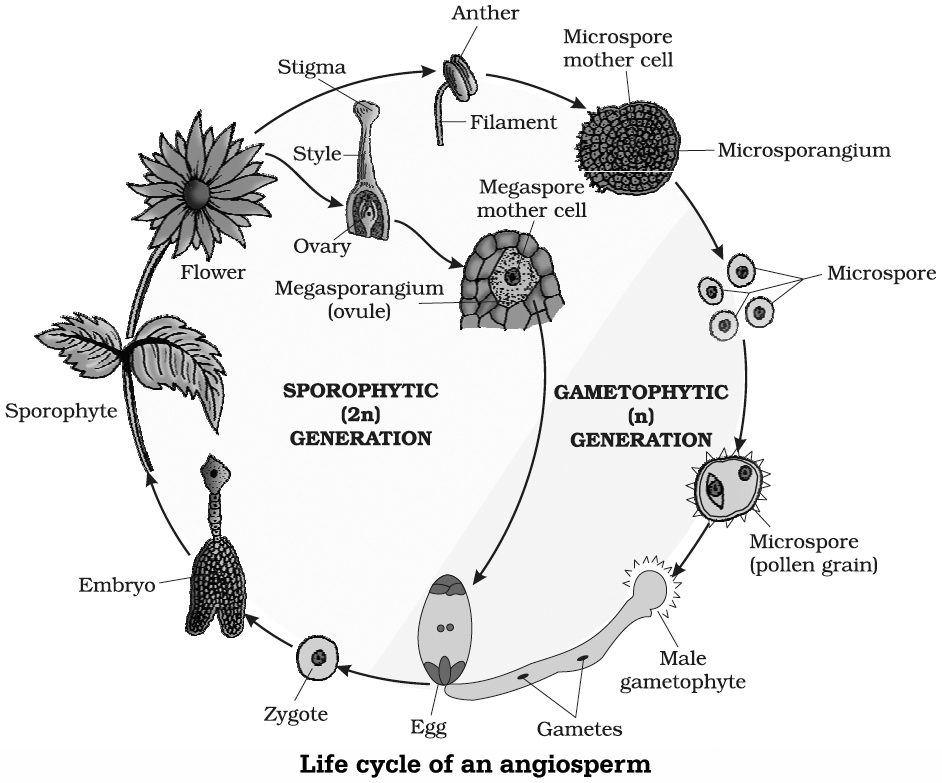
Angiosperms are those seed plants in which ovules and seeds are covered (inside fruits) and the sporophylls are organised into flowers. These are found in almost all the possible habitats. Tillandsia (Spanish moss) is an epiphytic angiosperm.
General characters
Flowering plants or angiosperms are the most recent and highly evolved plants.
Sporophylls are aggregated in flowers. It is their most striking feature. Therefore, angiosperms are also called flowering plants.
Stamen (male sex organ) consists of a filament and an anther. Carpel (female sex organ) is rolled and partly sterilised to produce a stigma, style and ovary, containing ovules.
Pollination occurs through several agencies, but most prominent amongst them is by animals, especially insects.
Pollen grains or microspores reach stigmatic surface found at the tip of carpel or megasporophyll (indirect pollination).
Female gametophyte or embryo sac is highly reduced and generally develops upto 8-nucleate stage prior to fertilization.
Archegonia are absent. Instead, there is one egg surrounded by two specialised synergid cells that attract the pollen tube. The latter brings two naked non-flagellate male gametes.
There occurs double fertilization . One produces zygote, hence embryo. The other forms primary endosperm cell.
Endosperm is formed through triple fusion and is generally triploid.
Fertilized ovules ripen into seeds. The seeds are covered by ovary wall. A fruit is technically a ripened ovary. Fruits not only protect the seeds but also help in their dispersal.
Xylem contains vessels.
Phloem possesses sieve tubes and companion cells.
Angiosperms are divided into two sub-groups-dicotyledons and monocotyledons, mainly on the basis of number of embryonic leaves or cotyledons. The two are commonly called as dicots and monocots.
Differences between dicots and monocots
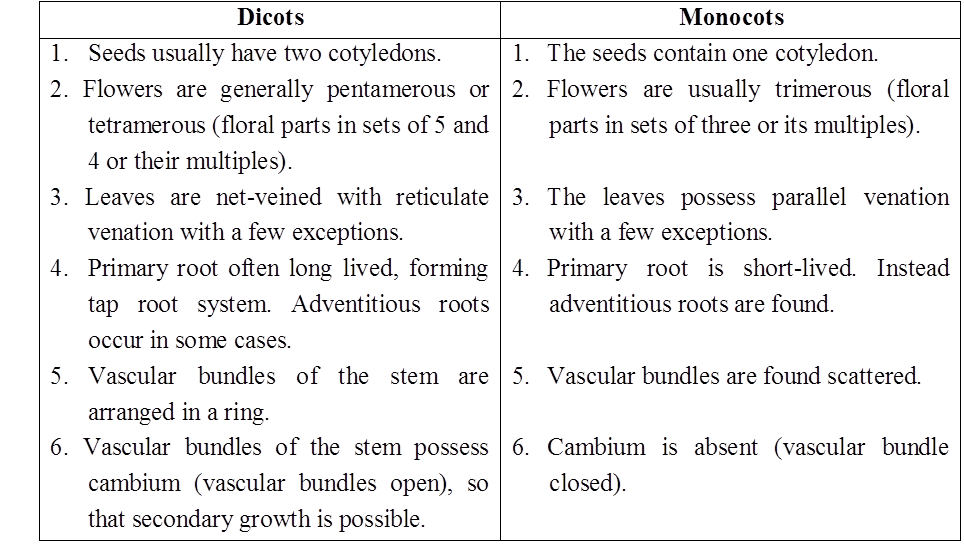
Differences between various plant groups having embryo
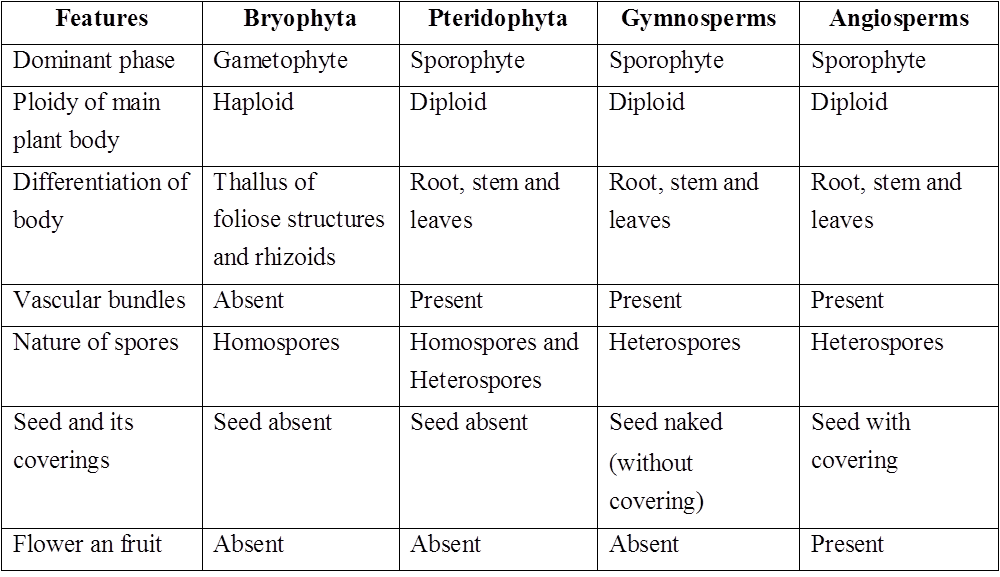
Plant Life Cycles and Alteration of Generations
- Books Name
- ACME SMART COACHING Biology Book
- Publication
- ACME SMART PUBLICATION
- Course
- CBSE Class 11
- Subject
- Biology
Plant Life Cycles and Alternation of Generations
Life cycle of a plant is called alternation of generations in plants, both haploid and diploid cells can divide by mitosis.
This ability leads to the formation of different plant bodies -haploid gamete producing plant (gametophyte) and diploid spore producing plant (sporophyte).
The haploid plant body produce, gametes by mitosis. Following fertilization, the zygote may divide by mitosis to produce sporophyte or may divide by meiosis to produce haploid spores.
Haploid spores in turn divide mitotically to produce gametophyte. Thus, during the life cycle of a sexually reproducing plant there occurs an alternation of generations between the haploid and diploid phases. Syngamy and meiosis seems to be instrumental for this event.
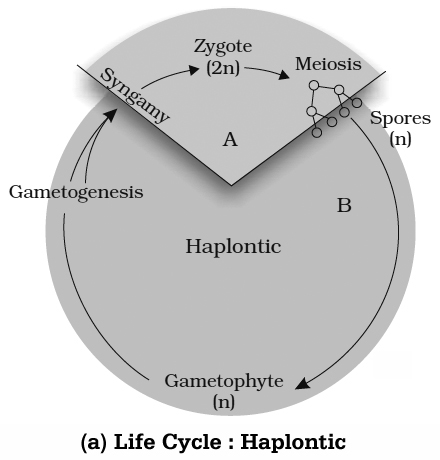
There are three chief patterns of life cycle. They fundamentally differ in the duration of the haploid and diploid phases. These are:
(i) Haplontic : It is characterized by the dominance of haplophase. The plant body is gametophyte and independent. The sporophyte is dependent on gametophyte, and is not a free living body. The major part of life is dominated by gametophyte, e.g., majority of green algae viz. Chlamydomonas, Ulothrix, Spirogyra etc.
(ii) Diplo-haplontic or Haplo diplontic: It is characterized by the existence of both sporophyte as well as gametophyte. Both of them are photosynthetic multicelled bodies and often free living with two nearly equal phases -the diplophase and haplophase. If sporophytes and gametophytes are morphologically different then the life cycle is termed as Diplo-haplontic-heteromorphic, e.g., all pteridophytes; all bryophytes some brown algae viz., Laminaria and other Kelps. If the two phases are morphologically identical, then life cycle is termed as Diplo-haplontic¬isomorphic, e.g., green algae viz., Ulva and Cladophora; brown algae, such as Ectocarpus
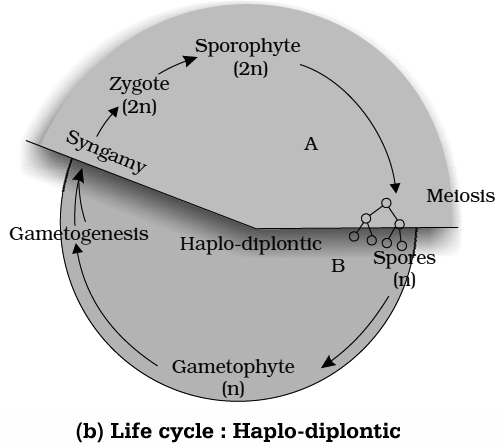
(iii) Diplontic : It is characterized by the dominance of diplophase. The plant body is sporophyte which is independent and free, living. The gametophytes are extremely reduced and are dependent physically as well as nutritionally on the sporophyte. The major part of the life is enjoyed by the sporophyte, e.g., all gymnosperms and angiosperms; Diatoms; some brown algae, viz., Fucus and Sargassum.
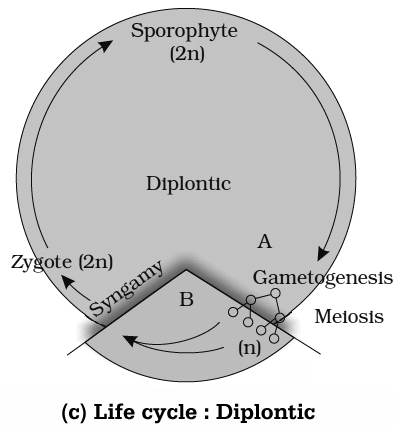

 Maria Habib
Maria Habib
